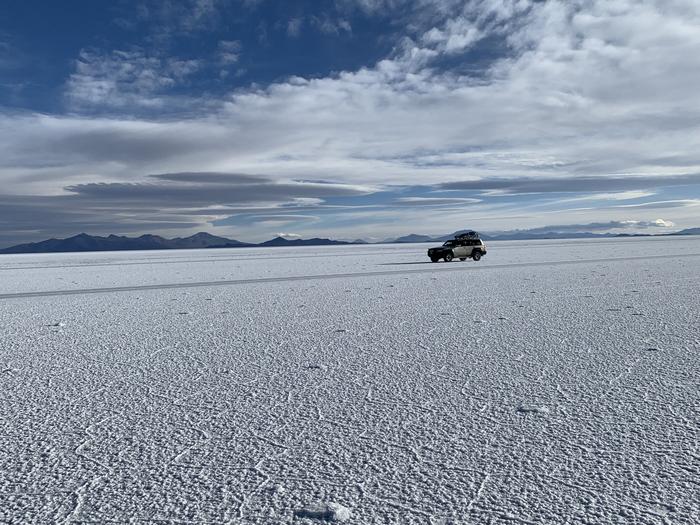
A US group has conducted the first thorough chemical analysis of wastewater associated with mining the lithium brine at the Salar de Uyuni, in Bolivia. Their findings could inform strategies to manage future mining operations and avoid the groundwater depletion and other problems that have affected sites like the Salar de Atacama in Chile.
The Salar de Uyuni is the location of the world’s largest known lithium deposit, and is a vast salt pan stretching for thousands of square miles atop a high, dry Andean plateau in Bolivia. For most of the year, salt crystals encrust the terrain, white as confectioner’s sugar. During the wet season, pooling rainwater mirrors surrounding mountains and sky.
“The Salar is a magical place for travellers from all over the world who come to see the colors, the reflections, in this endless white landscape,” said Avner Vengosh, Nicholas Chair of Environmental Quality at the Duke University Nicholas School of the Environment.
What most tourists don’t see is the vast reserve of lithium dissolved in highly saline, or salty, brine just below their shoes. Contained within sediments and salts that descend a few feet to more than 160 feet below the surface, this untapped trove could potentially be a key resource for the renewable energy sector.
For the past few years, Vengosh, who is also chair of the Division of Earth and Climate Sciences at the Nicholas School, and PhD student Gordon Williams have been working to understand the potential environmental health implications of lithium mining, both in the US and abroad.
Published in Environmental Science & Technology Letters in January, the duo reported their findings from the chemical analysis of wastewater associated with mining the lithium brine at the Salar de Uyuni.
Lithium-brine mining currently entails a multi-step process, whereby brine is pumped from below the surface into a series of shallow, above-ground evaporation ponds. As liquid evaporates in successive ponds, undesirable salts precipitate out. Lithium, however, becomes more concentrated in the brine at each stage. The concentrated lithium is eventually moved from the evaporation ponds to a nearby facility for processing into lithium carbonate — the material that goes into rechargeable batteries.
Lithium extraction at the Salar de Uyuni is in the preliminary stages of being developed. However, research has shown that long-term mining of lithium brines in other salt pans, such as the Salar de Atacama in Chile, can cause groundwater levels to decline and land to subside, or sink. Such impacts could affect the future of lithium mining at the Salar de Uyuni, according to Vengosh.
Williams and Vengosh analyzed the chemistry of lithium brine and waste materials associated with a pilot mining operation at the Salar de Uyuni. In particular, they were interested in determining acidity and the presence of trace elements, such as arsenic. Samples from the mine site included natural brine pumped from underground; brine from eight evaporation ponds; and wastewater from the lithium processing facility.
In natural brine samples, the team measured arsenic levels between 1 and 9 ppm, as well as relatively neutral acidity. In comparison, evaporation-pond brine became increasingly acidic as it became more concentrated.
Arsenic levels also dramatically increased from pond to pond. For example, the last pond revealed arsenic levels at nearly 50 parts per million — about 1,400 times higher than the benchmark considered ecologically acceptable by the US Environmental Protection Agency.
“This arsenic level is extremely high,” said Vengosh. “My group has worked all over the world — in Africa, Europe, Vietnam, India — and I don’t think we ever measured that level of arsenic.”
As the authors noted, leaking or intentional discharge of brine from the evaporation ponds to the surrounding salt pan could negatively affect wildlife.
“There’s a risk for bioaccumulation,” said Williams, referring to the process by which chemicals build up in organisms over time, with potentially harmful consequences. Flamingos, for instance, feed on local brine shrimp, which are sensitive to arsenic at levels above 8 parts per million.
The team also found that levels of boron — which can potentially cause health effects depending on the nature of exposure — increased from evaporation pond to evaporation pond. By contrast, wastewater from the lithium processing plant showed relatively low levels of boron and arsenic similar to, and in some cases lower than, levels found in the natural brines.
Additionally, Williams and Vengosh investigated the potential repercussions of taking spent brine — that is, brine left over after lithium is removed — or wastewater from lithium processing and injecting it back into the lithium deposit. The lithium-mining industry has indicated these approaches can counteract land subsidence.
The team found that both injection methods would have undesirable consequences. For example, the spent brine would likely mix poorly with natural brine, hindering the flow of brine below the surface and potentially interfering with pumping. On the other hand, injecting wastewater back into the deposit could dilute the lithium resource.
One potential solution to preventing land subsidence would be to carefully blend spent brine with wastewater to achieve a chemical balance with the natural brine. However, future studies should further investigate the environmental implications of that strategy, they added.
Williams and Vengosh are turning their attention to the origin of lithium at the Salar de Uyuni.
“We’re building a geochemical model to understand why lithium is enriched in those brines,” Williams explained. “What’s the source? And what’s the mechanism causing this concentration?”
The group is also attempting to understand how lithium-brine mining at the Salar de Uyuni could affect the health and well-being of neighboring Indigenous communities.
“We see lithium as the future for energy security, so we’re trying to analyze it from different angles to ensure sustainable development and supplies,” Vengosh said.






